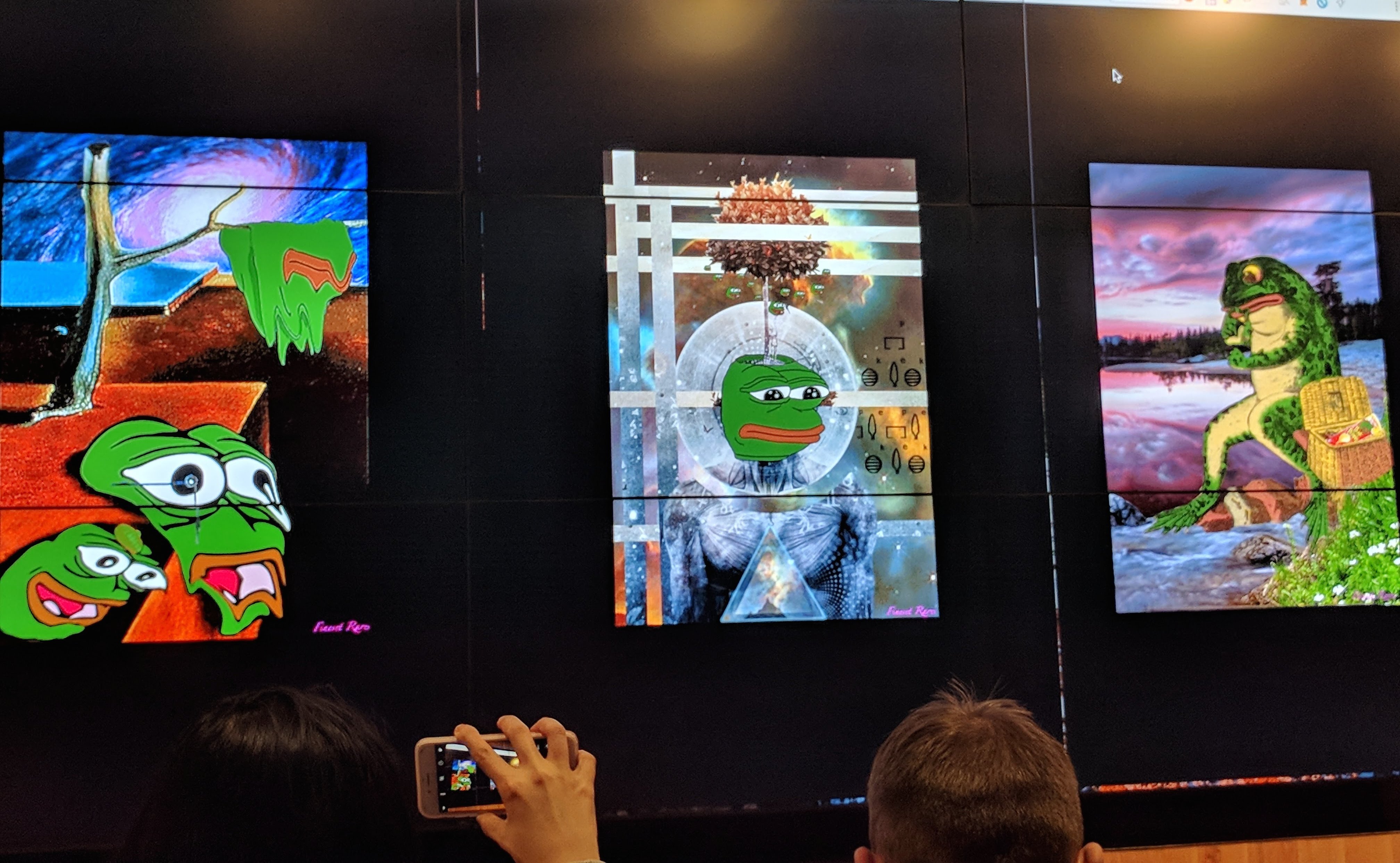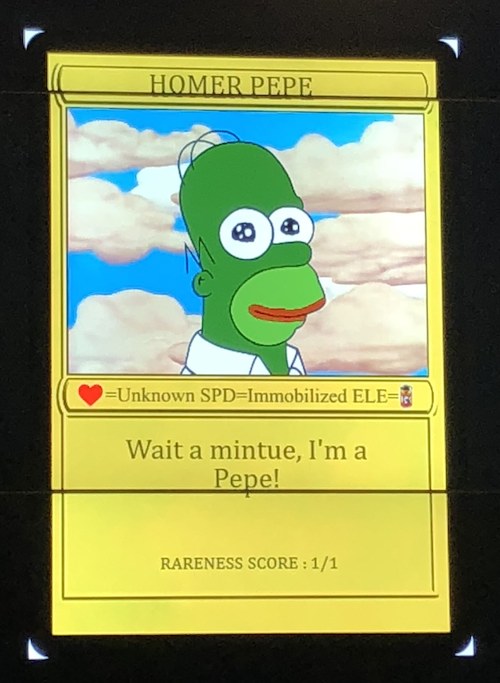On Saturday, January 13, hundreds of blockchain, digital art, and meme enthusiasts packed into a small event space on Manhattan’s West 23rd Street, some to place bids for images of a green frog—memes known as “Rare Pepes”—that live on the blockchain.
These Pepes aren’t alt-right memes or an authorized extension of the original artist Matt Furie’s body of work, however. They’re best thought of as collectible art pieces, and each one is associated with a unique digital token to prove its rareness. When Rare Pepes are bought and sold, the tokens change hands, and ownership is tracked on the Bitcoin blockchain, a decentralized ledger that can’t be edited.
Videos by VICE
The origins of the Rare Pepe phenomenon are murky 4chan apocrypha, but developer Joe Looney created the Rare Pepe Wallet, the main platform for buying and selling Rare Pepes, in 2016. I found myself sitting among an audience of his fans during this surreal live auction. I, like the few members of the establishment art world in the audience presumably, wanted to see what a live auction for collectible memes would look like. Could memes be sold like high-end art works?
The live auction kicked off with a set of three Rare Pepes, one of which looked like Salvador Dali’s The Persistence of Memory but with melting Pepes instead of clocks. The set sold for 12,000 units of Pepe Cash—an extremely liquid Rare Pepe of which there are 700 million units that serves as the de facto currency of the Rare Pepe world—which works out to just over $720 USD at the time of writing.

While live auctions in the traditional art world follow rigid rules and demand demure behavior from bidders, the first ever live auction for rare blockchain art got rowdier as the bidding went on. “I need that GIF!” a man wearing a beanie yelled when images of moving Pepe art appeared on screen by the auctioneer’s podium.
Later, the “most expensive rare Pepe in existence,” according to the auctioneer, sold after an enthusiastic but good-natured bidding war. It looked just like Homer Simpson, if Homer Simpson were a depressed green frog. “It’s Homer Pepe!” one audience member goaded, encouraging others to up their bids. “Jesus Christ,” said another as the bids continued to climb. Ultimately, the Pepe sold for 350,000 units of Pepe Cash, which currently amounts to $21,000 USD (a sum that, it’s worth mentioning, was worth $38,500 at the time of the auction).

The Rare Pepe auction (which, it should be noted, also included the sale of one CryptoKitty, a similar collectible on the Ethereum blockchain) capped off a day of panels and creator talks at the Rare Digital Art Festival. Tommy Nicholas, Kevin Trinh, and John Zettler from Rare Art Labs organized the day-long event meant for blockchain-based art creators and admirers.
Speakers at the event included members of the New York City-based art world and blockchain enthusiasts alike. During the Rare Pepe auction, staff from the Metropolitan Museum of Art, Museum of Modern Art, and Sotheby’s Institute of Art sat silently.
According to Rare Pepe auctioneer Louis Parker, some of the art establishment-types told him after the auction, “I don’t know what just happened, but it was incredible.” To him, the presence of these big institutions indicates the start of both blockchain technology and meme culture creeping into the mainstream art realm. Parker, it’s worth noting, will soon launch his own blockchain-based network for memes, called Archetype.
Read More: The Big Business of CryptoKitties Is Being Automated
Stuffy Sotheby’s staffers weren’t the only ones shaking their heads during the auction. Even as a self-described member of the “crypto-nerds” contingent at the event, Matt Hall—who co-founded CryptoPunks, another digital art creation to avail blockchain technology to ensure uniqueness and track ownership—recognized the rare Pepe enthusiasts as a group unto itself. To him, the project is “a bit confusing,” albeit intriguing, and full of in-jokes he doesn’t understand.
Despite the items for sale being totally digital, the auction itself was remarkably human. Though one audience member yelled out bids on the behalf of remote buyers, “All of the big bidders were there in person,” Tommy Nicholas, one of the festival’s organizers, told me. Next time, though, the team wants the auction to be bigger and to include more remote participants. Moreover, Nicholas said, the team is looking to partner with an established art house in the coming months to do a dedicated Rare Pepe auction event.
When speaking to art industry professionals after the auction, Parker saw them beginning to reckon with the merging of art, the blockchain, and, yes, even memes.“Are memes art? Is art memes? What’s the difference?” Rare Pepe auctioneer Parker wondered aloud.
If attending the first ever live Rare Pepe auction taught me anything, it’s that if people are willing to spend digital assets worth nearly $40,000 on these things, then the traditional art world is going to have to ask itself Parker’s tough questions whether it wants to or not.
Get six of our favorite Motherboard stories every day by signing up for our newsletter .




